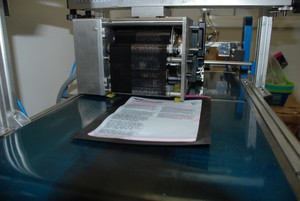

|
Edward Lowton
Editor |


|
| Home> | Plant, Process & Control | >Labelling, marking and barcoding | >Quick to tackle bait packaging problem |
| Home> | Handling and Storing | >Labelling, marking and barcoding | >Quick to tackle bait packaging problem |
Quick to tackle bait packaging problem
03 August 2015
When Nash Tackle suddenly found itself under pressure to include nutrient and ingredient declarations on all of its fishing baits, product feeding and coding specialist Rotech came to the rescue with a flexible offline system capable of overprinting pouches with shoals of different data.

Essex-based Nash Tackle supplies fishing tackle shops with everything from bivvies and shelters to rods and reels. Baits are a major chunk of its business, with a portfolio that takes in hundreds of different boilies, pastes, stick mixes and pellets, formulated with patented performance ingredients and additives.
In 2012, exporting to Europe became more complicated for Nash, following a crackdown by European labelling regulators. Nash had been using the same generic back-of-pack wording on its exported baits as it was using for the UK market. However, the authorities made it clear that this approach would no longer be acceptable – fishing bait products had to carry a description and full list of ingredients in the relevant European language.
For Nash, with its vast range of products, the implications of this were massive.
Gary Bayes, operations director at Nash Tackle, explains that the company urgently needed a means of printing language variants of lots of different packs. A word of mouth recommendation led Nash to Rotech who immediately set about modifying a demo model. Within two weeks, Nash had taken delivery of a customised RF1 offline coding system with vacuum pouch feeder and a BELL-MARK EasyPrint C thermal transfer printhead.
Whereas many offline coders use a friction feeder to drive the bottom sleeve or carton from the stack for printing, this method doesn’t work for difficult-to-feed flexible pouches, as Rotech director Richard Pether explains: "If you try to draw off the bottom bag from a stack by use of friction you will only succeed in moving the entire stack. Our solution has been to develop a stack-to-stack system that uses versatile vacuum pick and place technology to feed and print pouches at speeds of between 20 and 30 per minute. The RF1 works from the top of the stack down, picking the top bag and placing it on an integral conveyor for printing, prior to being stacked again.”
At Nash’s bait factory, the RF1 coder has made it possible for the company to overprint pre-made pouches with over 3000 slightly different versions of back-of-pack information and barcodes, on demand – satisfying regulators without compromising production efficiency.
Gary Bayes adds: "We needed the ability to print large amounts of variable information onto different sized bags, and the flexibility to print these bags on demand. Rotech’s system has delivered on both counts - catering for the extremely broad product range we supply and the markets we serve. The print quality is awesome. It is clean and precise - you can read it even at a font size of 0.4. The barcodes are also very clear, which is important to the fishing shops we supply, as they don’t want to have to deal with illegible barcodes.”
Nash also had to enlist Rotech’s assistance when it introduced a new PET/LDPE pouch material that didn’t seem to want to run on the system. Bayes explains: "Rotech’s support was superb. They tested loads of different ribbons until they found the right one. They also altered the way the machine was picking up the bags to enable it to run the new pouches,” says Gary.
Now, Nash is confident that it has a future-proof system that can overprint whatever information it wants on its pouches, and in whatever language is needed.
- Uncoding the benefits of TIJ
- Autoglym get shining results with new coding technology
- Feeding for coding: One size doesn't fit all
- Sleeve coding
- Label-free, large area printing
- Inline carton feeder aids pharma traceability
- Rotech introduces anti-counterfeit UV printing
- Coder proves a recipe for success


















